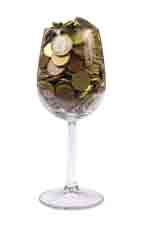Price – the most influential factor for Irish wine consumers
The All-Ireland wine market stood at €1.4 billion in 2010, having fallen from €1.5 billion in 2009 according to Mintel in its new report, Wine Ireland 2011. The majority of this decrease happened in the on-trade as Irish consumers increasingly forsook pubs and bars in favour of drinking at home.
On the other hand, the all-Ireland off-trade experienced year-on-year growth between 2005 and 2010, with Irish consumers possibly drinking wine at home with meals and/or while entertaining guests.
On- losing to off-
The All-Ireland on-trade wine market shrank by an estimated 13 per cent between 2009 and 2010, from €393 million to €342 million, according to Mintel which put the RoI on-trade wine market at €292 million or 25 per cent, with the off-trade accounting for €768 million in 2010.
Some 34 per cent of consumers claim to be more likely to drink at home — six per cent more in 2010 than in 2005.
Brian O’Connor, Senior Consumer Analyst at Mintel, points out that the tendency to entertain at home rather than go out isn’t likely to change while the recession eats into consumers’ leisure spend, with the opportunity to sell premium wine diminished for the foreseeable future.
“While some people are still willing to pay for brands, they require some justification for splashing out,” he stated, “If a higher price tag cannot be justified in the recession, consumers simply won’t pay for it.”
It’s estimated that the all-Ireland wine market will stabilise at €1.4 billion in 2013 and that between 2010 and 2013 the on-trade market will contract by 18 per cent with off-trade growth of six per cent.
An increase in consumers hosting dinner parties may have helped sustain off-trade wine sales, according to Mintel, with 39 per cent of consumers drinking wine when having dinner at home with friends and 29 per cent drinking it while dining with the family at home.
Furthermore some 68 per cent claim that when they have friends around for drinks they’re more likely to buy better quality alcohol.
Wine over beer
Data from TGI finds that 59 per cent of Irish consumers are likely to buy wine for home consumption rather than beer (52 per cent).
However the trend to in-home drinking has eroded alcohol brand loyalty somewhat. 54 per cent claim to be less loyal to brands than they used to be, as price is now paramount with 19 per cent of consumers having bought own-label alcohol in the last 12 months.
Typically, the average wine drinker spends between €6 and €10.50 on a bottle of wine with the recession seeing them unlikely to boost spend per bottle in the near future. 35 per cent are unwilling to pay more for good quality wine.
Online wine purchasing is on the increase with the DIGI claiming a third of drinkers have bought wine online (September 2010). Consumers are more likely to buy from a supermarket website than a wine specialist.
Wine preferences
Sales of red wine account for half of sales values with white accounting for 45 per cent and Rosé for five per cent, according to Mintel.
39 per cent of consumers drink white wine; 32 per cent drink red (TGI 2010).
29 per cent of consumers have consumed Australian wine in the last 12 months, the most popular type of wine compared to Chilean, French and South African.
According to Brian O’Connor, “One reason that Australian wines are drunk more by Irish consumers is due to their relative cheapness compared to European wines, while still being seen as having a good quality flavour. However a key challenge for the overall Irish wine industry going forward will be to encourage consumers to opt for more premium bottles of wine and avoid the temptation to trade down to cheaper bottles of wine to save money or indeed changing to different forms of alcohol. Ultimately, price is the most influential factor for consumers – and the unstable economic climate will only further encourage this”.
Mintel offers a number of suggestions on how to sell more wine.
How to sell more wine
Restaurants and off-licences might benefit by partnering up with one another. A restaurant offering a BYOB (Bring Your Own Bottle) service could partner with a local off-licence offering customers a special deal to help encourage more consumers eat out while helping off-licensees boost trade.
Catering to the mature wine drinker
The Broader Market Environment section of Mintel’s report notes that consumers aged 55-plus are increasingly a key target audience for the wine market, with more spending power and free time than younger drinkers.
“When branding a wine, it’s important to consider that mature consumers are an
important consumer of wine and to position the brand and change its image to suit consumers in this age group,” states the report, “A brand that reflects their desire for refined and sophisticated drinks is likely to attract their attention.”
Catering to the in-home wine drinker
‘Dining out’ at 54 per cent and ‘Entertainment/Socialising (pub, cinema etc)’ at 51 per cent figure alongside ‘Clothing Accessories’ (54 per cent) in ‘areas where consumers have cut back in spending in the last 12 months’ according to a Millward Brown Mintel survey last July.
With the increase in in-home drinking, Mintel suggests making smaller bottles available in off-trade channels to help to foster healthier drinking habits.
“A bottle with three or less servings will allow drinkers to avoid the temptation of ‘just finishing off a bottle’,” states Mintel.
Using more screwtops might help wine suppliers to encourage more responsible drinking. Consumers will find it easier and more convenient to use a screwtop bottle to store wine, possibly making it last for several drinking sessions as opposed to uncorking a bottle and being compelled to finish it.
Hotels present a particular opportunity for wine companies to encourage consumers to buy higher cost wines as they may be there for a special occasion and feel it warrants a more special wine.
The majority of Irish consumers have limited knowledge on wines. 57 per cent of consuemers called for clearer labeling on drink products (Toluna 2010) while TGI data from 2010 shows that a third of consumers read the label of a product before buying it. So clearer labeling could help boost sales of underperforming wine brands.
For more information contact: http://www.mintel.com

“Ultimately price is the most influential factor for consumers – and the unstable economic climate will only further encourage this”.








